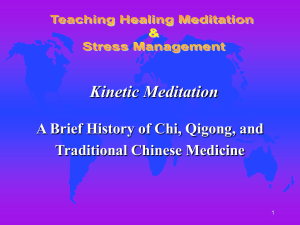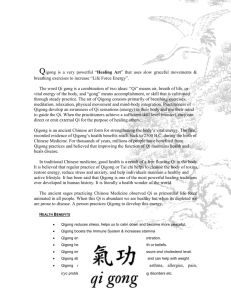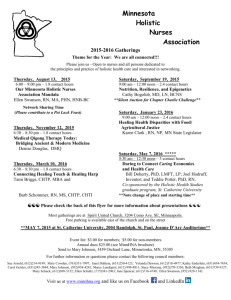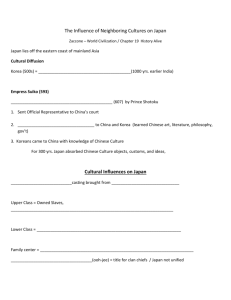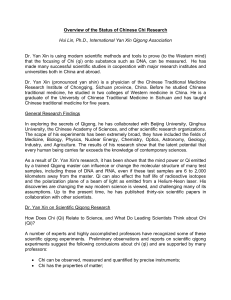The concept of harmony and self-cultivation
advertisement
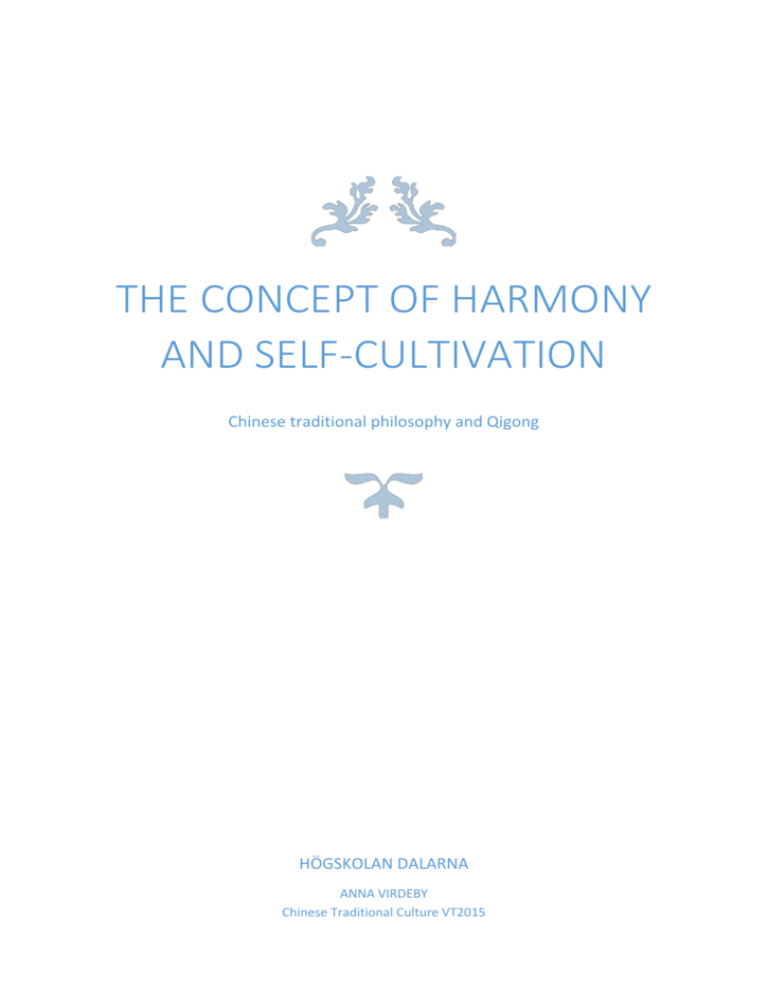
THE CONCEPT OF HARMONY AND SELF-CULTIVATION Chinese traditional philosophy and Qigong HÖGSKOLAN DALARNA ANNA VIRDEBY Chinese Traditional Culture VT2015 Introduction The origins of traditional Chinese philosophy, and Confucianism and Daoism is a period of war and great turmoil. A period of time where educated thinkers in China and officials (shi) would struggle to create more peaceful living conditions. Thinkers during this period shaped different theories regarding concepts like morality, political society and good governance. Buddhism in China gained influence later in history, during the Tang dynasty, and may have offered a more religious and metaphysical theory in relatively more peaceful time in China. The historian Sima Tan (died 110BCE) was one of the first to categorize the different lines of thought in early China.1 This essay will briefly investigate the concept of “Harmony” and “Self-cultivation” in these three major philosophical lines. I will also explore how these concepts still are practiced today in Qigong. Qigong is the Chinese Medicine method for meditation which is also considered to have therapeutic effects. 2 Finally, I will also shortly explore some correlations between these concepts and traditional political society. The concept of Harmony and Self-Cultivation First of all, in Chinese philosophy, an individual is a relationally constituted and situated self. This means that there are many factors that shape the self, such as relationships with others and experiences in historical, cultural, social and political context. The concept of self-cultivation was developed in belief that the purpose of learning was to better oneself and hence, better the society. For Confucians, a self-cultivated person was someone who legitimately had the ability to lead the people, while for Daoist thinkers, self-cultivation was to nurture oneself and keep the self unadulterated from the corrupting influences of society. Nevertheless, the different lines of thinking share the view of individuals as contextually situated and interdependent. Further on, they all pointed out the importance of self-cultivation. Good relationships were seen as central to a good life, and self-cultivated people with harmonic relationships would build a stable society.3 The doctrine of self and self-cultivation in Chinese Buddhism is not as clear in context of the society and state, as this essay will present. Confucianism Social harmony and stability were critical issues for the early thinkers in China, the thinkers concentrated on processes and methods that could ensure a stable and peaceful existence. Good relationships were seen as a fundamental element towards social stability. For Confucians, the family was a microcosm of the state, and the state a macrocosm of human interrelations guided by institutions and government. The concept of harmony (和) is the equivalent of a harmonious state or society. Therefore, Confucianism and the Ru-ist education, resided in the cultivation of an ethically and ritually disciplined life. Harmony is obtained by human benevolence (ren), through self-cultivation (xiushen) and is guided by rituals/rules (li) that should be applied in both private and official life.4 The terms ren and li are two fundamental concepts in Confucianism. Together they represent the Confucian ideal of cultivated humanism. Ren symbolizes a form of humaneness, the human virtue of compassion. The cultivation of ren begins with the development of family relationships, meaning that one first learns about human attachment through interaction with family members. The skills learnt in the family environment are vital for person’s interactions with others. Ren is also associated with a kind of ethical wisdom. The concept 1 2 3 4 Karyn L. Lai, An Introduction to Chinese Philosophy; Cambridge University Press: p.1-4 Elisabeth Hsu, The transmission of Chinese Medicine; Cambridge University Press: p.21 Karyn L. Lai, An Introduction to Chinese Philosophy; Cambridge University Press: p.4-8 Ibid: p.8-11 1 of li represents a form of normative codes of conducts that serves as a guide for correct behavior in a range of different contexts: between children and parents, subject and ruler and prince and minister. These rules are not to be confused with penal law, Confucians argued that ren together with li would form a kind of moral within the individual, instead of just obeying the legislation in order to avoid punishment.5 Daoism Daoist philosophers embraced multiplicity and plurality and reflected on natural events in the world. They praised the non-homogeneity in society and differences between individuals and views. Therefore, harmony was viewed as a lively interchange between different points of view. Hence, the Daoist theory is a holistic view which often looks at and reflects on events in the natural world. Daoism also represents a form of correlative thinking. An example is the correlation drawn between a dysfunctional state and a diseased body, both lacking in alignment between parts and is therefore disharmonious.6 Moreover, the Daoist thinkers meant that self-cultivation was to keep the self pure from the corruptions of society. The purpose is to experience dao (the way or all-embracing). The self was regarded as part of dao along with nature. That means that dao is all and contains everything “all-under-heaven” (tianxia). The two main principles of dao are wuwei (non-action) and ziran (spontaneity). Wuwei can be translated as a kind of acceptance and non-coercion. This holistic kind of view includes the belief that the whole is merely the sum of its parts, harmony is in the plurality or dao – the all-embracing.7 (chinese characters could have been introduced after the pinyin for consistency in the text) Buddhism Buddhism entered China during the 1st century, but developed into Chinese Buddhism during the 5th century. Buddhists regarded the self as a thinking and conscious self that acts and interacts in the everyday world. This phenomenal self is constituted by five different processes: Material processes Sensations: contact with the world through the six senses Perceptions: cognition of material and mental objects through the six senses Physic dispositions: psychological emotions, impressions and volitional processes that influence behavior. Consciousness: awareness of self and awareness of the world. Buddhist thinkers considers (the present tense is always preferred in academic writing as a descriptive tense, unless you are referring to historical events) the self as a part of an interdependent causality that underlies processes and events. The doctrine of interdependent causality has important moral implications since the self is both acting and acted upon in different situations. The self is both conditioned by causes and generates consequences that condition others in the future. Every action (karma), whether physical or mental, is followed by correlated consequences. Therefore, it is important to cultivate right mindfulness and right concentration. The concept of karma is correlated to the doctrine of self. The true self is a psychophysical self, which is defined as a stream of consciousness that continues despite of the death of the physical body it is associated with.8 5 6 7 8 Ibid: p.8-11 Ibid: p.11-14 Course notes, Chinese Traditional Culture VT2015 Karyn L. Lai, An Introduction to Chinese Philosophy; Cambridge University Press: p.237-241 2 In China, Buddhism was influenced by earlier Chinese philosophies, particularly Daoism, and had a more practical orientation. It states that the world as perceived through our senses is not real. Instead, Chinese Buddhism concentrated on problems of conception (due to the five different processes listed above) and argued that subjective prejudices limit our interpretation of the world. Hence, most of our knowledge tends to be false. And because of this, life would be limited or filled with suffering. Meditation and/or yoga was said to be the way to obtain insight to the truth.9 Summary of Harmony and Self-Cultivation in Chinese traditional philosophy Confucianism, Daoism and Chinese Buddhism all regard the self as a product of depending of many factors such as: relationships with others, history, culture, subjective prejudice etc. But they cannot be said to represent individualistic theories, instead the individual is seen as interdependent from the rest of society. For Confucians, self was equal to the concept of ren – humaneness. Self-cultivation was considered to better oneself in order to improve society and make it peaceful and harmonious. This was to be done through both ren and li. Li is the concept of behavioral guidelines that condition the relationships in different social contexts. Confucians believe that in order to create a harmonious state, one must start with the private relationships in the family since the family was considered as a microcosm of the state (and the state as a macrocosm of the family). It is debated whether ren or li is the fundament for a harmonious state, or if they are interdependent of each other. When it comes to Daoism, the self is regarded as a part of nature. For Daoists, man is therefore part of nature, and nature a part of man. Self-cultivation is to nurture oneself and to being unadulterated of the society’s influence. Dao, the way, is to embrace the interchange of all different point of views. Harmony is the belief that the whole is merely the sum of its part and in plurality. Daoism also uses a kind of correlative thinking such as making the comparison between a diseased body and a dysfunctional state. A harmonious state, according to the Daoist doctrine, does not seem to concentrate on behavioral rules such in Confucianism, but in the acceptance of co-existing differences and a holistic point of view where observing nature is an important component. In Chinese Buddhism, the self is determined by previous causalities and is divided into the physical body and a stream of consciousness that continues even when the physical body is deceased. The self is conditioned by five different processes where the six senses, cognition, emotions and consciousness plays an important role. The doctrine focuses on problems with these processes and argues that because of dysfunction of any of these processes, mans’ knowledge and perception of the world is not true. Selfcultivation can be argued as having a mind “clear as a mirror” through which we can perceive and interpret the world as the truth, or to be enlightened. The theory of enlightment toghether with that of karma (which provides a kind of guidelines for the actions of the self) can be said to represent the concept of harmony in Chinese Buddhism. While Confucianism focuses on a harmonious state, and Daoist thinkers were orientated on natural phenomena and the holistic entity, Chinese Buddhism seems more orientated on the enlightment of the individual. 9 Ibid: p.249-253 3 Qigong Qigong became very popular in China under Deng Xiaoping’s leadership in the 1980’s but the word qigong was first found in a text during the Jin dynasty (AD 265-420). Qigong often refers to the reinterpretation of Daoist practices under the impact of modern medicine but has a wide range of practices. It was originally defined as a “self-cultivation practice” but is currently called “a breathing technique”. Qigong is nowadays known mostly as a meditative practice with therapeutic effects.10 During the Warring States period (475-221 BC), the practice of Qigong was said to nurture one’s life (yangsheng), to guide and lead qi (daoyin) and to cultivate oneself (xiushen). Present day practice of Qigong is often based on former Daoist meditation traditions and sometimes including elements of Buddhist meditation practices. Formerly, all Chinese doctors’ engaged in meditative practices such as qigong for selfcultivation and in order to strengthen one’s inner qi (neiqi).11 (chinese characters as above) When the practice of qigong became more widely known in the 1950’s it was promoted in the context of public health care. In 1955 the first qigong rehabilitation centre was established, and patients with gastrointestinal disorders were taught Inner Nurture Qigong (neiyanggong). Qigong was thereafter taught in several rehabilitation centres all over China and was promoted as particularly effective for the cure of chronic hepatitis, high blood pressure, heart palpitations, tuberculosis, asthma, neurasthenia, diabetes, glaucoma and toxaemia.12 Qigong was discredited as superstition during the Cultural Revolution (1966-76) but was revived in the late 1970’s and 1980’s. During the 1980’s qigong was more widely spread. It was regularly practiced by both women and men, state employees, pensioners, and unemployed youth. Qigong was not only practiced at home or in a park, there were also organized qigong meetings with famous qigong masters in sport stadiums and university auditoriums. Private qigong practices promising a sure and safe cure was opened in and around the cities. The revival of qigong during the 1980’s were attributed to the head of the state. Rumor had it that Deng Xiaoping was treated by a qigong healer, and of course also Mao Zedong’s earlier personal experiences with Chinese Medicine helped to promote Chinese traditional medicine during this time.13 Concepts of qigong practice As described above, qigong can be described as a form of meditation. In order to find the concentration to meditated an “upright mind” (zhengxin) and a clear conscience is fundamental. Purity of mind is paralleled by the purification of the entire body such as respecting food taboos, clean the meditation room, washing the entire body and abstain from sexual intercourse. The meditation is to take place at a precise time of the day, preferable during the zi hours around midnight (11 p.m. – 1 a.m.). These preparations/rules have features common with both Daoist and Buddhist traditions. Qigong masters are believed to be extremely powerful and often acts on ethical grounds. To become a healer, it is important to cultivate one’s Inner qi through the practice of qigong. This training is surrounded by great discipline and is often based on Daoist incantations and by reading books full with drawings of Daoist signs. The pupil has to engage in both qigong 10 11 12 13 Elisabeth Hsu, The transmission of Chinese Medicine; Cambridge University Press: p.21 Ibid: p.22 Ibid: p.23 Ibid: p.23-24 4 healing performances and meditation, memorize Daoist incantations and learn how to write the Daoist signs. In order to make the incantations work during the healing of patients, one also have to learn the exact pronunciation of each spoken word. Only the correctly pronounced word has power. These Daoist incantations and sigs is furthermore often to be kept as a secret. In terms of self-cultivation, all these rituals aim to aestetic aspects such as scents, for example of jasmine blossoms, which may emanate from the qigong master’s body, and to the visualization of different colored lights during meditation.14 The goal for qigong meditation (or treatment) is primarily to restore balance in the body and hence, harmony. Another important principle in qigong is only to tread committed clients. The ancient Chinese doctor Bian Que wrote “Never treat those who believe in shamans and not in doctors” as his sixth principle of ethics. This means that there have to be a mutual commitment between the qigong healer and the patient. The patient is expected to attend several qigong sessions and furthermore to engage in meditation at home and to practice qigong movements.15 The ritual activities of a qigong healing session includes more than just a cleansing of the body. It also includes the theory of qi and the five elements (wuxing). Qi is simplified said to be all energies both inside the body and outside it – all under heaven. The five elements relates to natural phenomena such as wood, fire, earth, metal and water. Chinese medicine, and qigong, is primarily directed at regulating these complex processes analogous to microcosm and macrocosm. For instance, bad qi (xieqi) can be taken away from the body and original qi (yuan qi) can be strentghed. The theory of qi and the five elements are first recognized in the book of Classic of Difficult Issues (Nanjing), written during the Han-dynasty (206 BC – AD 220).16 The body ecologic Chinese Medicine is based on the concept of “The body ecologic”. In short this means that it includes the concerns of people in their interaction with the natural environment. In China, the idea that processes in the macrocosm and the microcosm are analogous. The cosmos, the state, and the body is seen as so interdependent that they are considered a single complex. Chinese medical doctors states that there are several different pathogenic kinds of qi that relates to nature; cold, dry, damp, wind etc. There is simply just not one qi but a whole chorus of them. Also in qigong, disharmonic dynamics of qi is held responsible for disorders in the body. This concept can also be paralleled to “body politic” – an idea of power relations of the society at large, and the way they are embodied in individuals. In short, the body ecologic, or body politic is the idea that body and environment cannot be dealt with as separate entities. This contrasts the western view of the separation of the individual body and the social body (as in governmental institutions).17 As mentioned earlier in this essay, ancient Daoist thinkers made a correlation drawn between a dysfunctional state and a diseased body, both lacking in alignment between parts and is therefore disharmonious. Conclusion There is a clear connection between Daoist thinking and the practice of Qigong. Qigong was traditionally used as a self-cultivation practice in order to nurture one’s life. Today Qigong is mostly known as a meditative practice but is also a part of public health care since it is considered to have therapeutic effects. Qigong 14 15 16 17 Ibid: p.33-57 Ibid: p.59-64 Ibid: p.68-75 Ibid: p.78-83 5 meditation is based on Daoist signs and incantations but there are elements of Buddhist meditation practices as well. For instance, it is said that one should have a clear and upright mind in order to find the right concentration for meditation. There are also several cleansing rituals to be done before undertaking a qigong session. These ideas can be paralleled to the Buddhist idea of the true self. The Qigong masters are said to act on ethical grounds based on traditional Chinese thinking in both Confucianism, Daoism and Buddhism. A person that wishes to become a qigong master must follow rituals that contains many disciplined rituals (li) based on Daoist and Buddhist philosophy. For example, it is not enough just to memorize signs and incantations – they have to be written and pronounced in the exact correct way for being effective. The pupil’s goal is to experience phenomena arising from the physical body – such as scents deriving from the palms or visualizing different kinds of light during meditation. Furthermore, the patient seeking qigong treatment, also have to be committed to self-cultivation through the attendance of several qigong sessions and at home practices. All these rituals, both for the qigong healer and the patient, clearly shows that qigong includes a great deal of practices for self-cultivation that can be connected both to the Daoist, Confucian and Buddhist concept of self-cultivation. All the qigong rituals strive for achieving balance – harmony – in the body. Chinese medicine, and qigong, includes complex theories of natural events that are applied to the mental and physical state of the body. As mentioned, there are theories of the five elements and pathogenic qi that are correlated to wind, cold, water, fire etc. Moreover, the concept of qi is said to include all that is under heaven (tianxia) and there is no line drawn between qi of in- our outside the body. This connection to nature in Chinese medicine is clearly associated to the Daoist idea of the all-embracing and that man is a part of nature. Additionally, the Confucian idea of correlations between a microcosm and macrocosm is present in both Chinese medicine and qigong. Chinese philosophy states that an individual is a relationally constituted and situated self. The self is said to be interdependent of relationships with others and experiences in private and public life. Just as harmony is the goal for qigong practice, harmony is also the goal of Chinese traditional thinking regarding political society. The Confucians meant that self-cultivation through ren and li would better the society. For Daoist thinkers, self-cultivation was to nurture oneself and to experience dao, the all-embracing or all-underheaven. That is, harmony is the acceptance of the plurality in the world and the idea of man and nature as one unit. Harmony to Buddhist thinkers is to cultivate oneself through meditation so one could transform into the true self. Chinese medicine is based on the concept of the body ecologic – peoples’ interaction with the natural environment. The body and the state are seen as interdependent entities. A good example of this is the Daoist comparison between the diseased body and a dysfunctional and disharmonic state. Qigong, and other Chinese traditional medicinal treatments, were promoted by the Chinese government during the 1980s (1980s). Central political figures such as Mao Zedong and Deng Xiaoping were said to have positive personal experiences with Chinese medicine and qigong. A most personal reflection is that the practice of Chinese medicine was promoted – not just for economic reasons – but for the elements of self-cultivation related to Confucian thinking. The Buddhist elements in qigong could have been one of the reasons of why the practice were banned as superstitious during the Cultural Revolution. It is also interesting to note how 6 qigong was revived as a breathing technique – and not as a method for self-cultivation in the 1980s. It is still to be shown whether the body politic will have a revival or not in the Chinese society. 7
